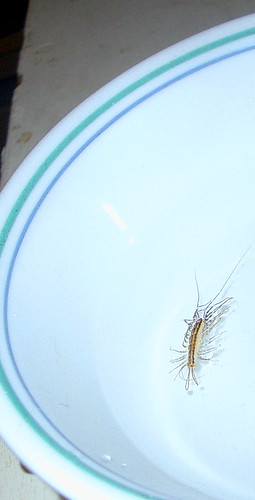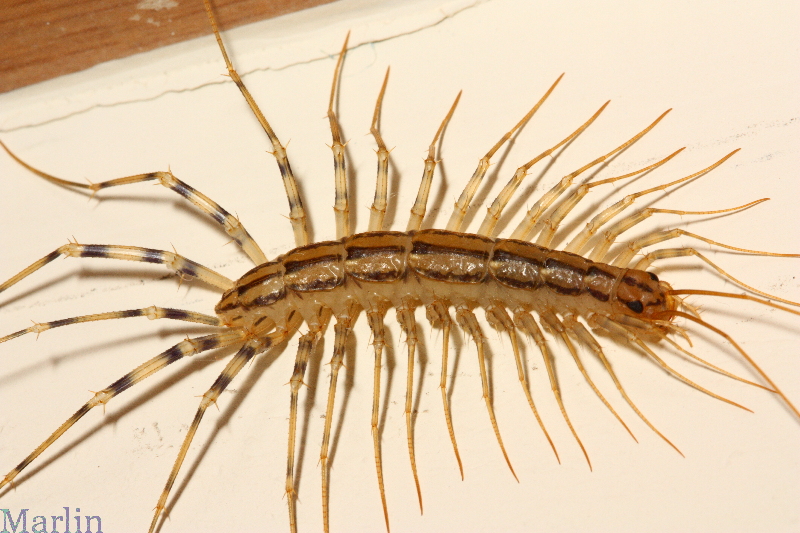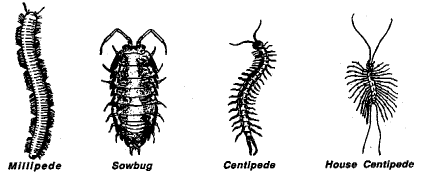In 1902, C.L. Marlatt, an entomologist with the United States Department of Agriculture wrote a brief description of the house centipede:
House centipedes lay their eggs in spring. In a laboratory experiment of 24 house centipedes, an average of 63 and a maximum of 151 eggs were laid. As with many other arthropods, the larvae look like miniature versions of the adult, albeit with fewer legs. Young centipedes have four pairs of legs when they are hatched. They gain a new pair with the first molting, and two pairs with each of their five subsequent moltings. Adults with 15 pairs of legs retain that number through three more molting stages (sequence 4-5-7-9-11-13-15-15-15-15 pairs). They live anywhere from three to seven years, depending on the environment. They can start breeding in their third year. For mating the male and female circle around each other. They initiate contact with their antennae. The male deposits his sperm on the ground and the female then uses it to fertilize her eggs.
House centipedes feed on spiders, bedbugs, termites, cockroaches, silverfish, ants, and other household arthropods. They administer venom through modified legs. These are not part of their mandibles, so strictly speaking they sting rather than bite. They are mostly nocturnal hunters. Despite their developed eyes they seem to rely mostly on their antennae when hunting. Their antennae are sensitive to both smells and tactile information. They use both their mandibles and their legs for holding prey. This way they can deal with several small insects at the same time. To capture prey they either jump onto it or use their legs in a technique described as "lassoing". Using their legs to beat prey has also been described. In a feeding study, S. coleoptrata showed the ability to distinguish between possible prey. They avoid dangerous insects. They also adapted their feeding pattern to the hazard the prey might pose to them. For wasps, they retreat after applying the venom to give it time to take effect. When the centipede is in danger of becoming prey itself, it can detach any legs that have become trapped.
Outdoors, house centipedes prefer to live in cool, damp places. Centipede respiratory systems do not provide any mechanism for shutting the spiracles. That is why they need an environment that protects them from dehydration and excessive cold. Most live outside, primarily under large rocks, piles of wood and especially in compost piles. Within the home, these centipedes are found in almost any part of the house. Most commonly, they are encountered in basements, bathrooms and lavatories, which tend to be humid, but they can also be found in drier places like offices, bedrooms and dining rooms. The greatest likelihood of encountering them is in spring, when they come out because the weather gets warmer, and in autumn/fall, when the cooling weather forces them to find shelter in human habitats.
Scutigera coleoptrata is indigenous to the Mediterranean region, but it has spread through much of Europe, Asia, North America and South America. It is thought to have first been introduced in the Americas in Mexico and Guatemala and now it reaches north into Canada and south to Argentina. In the United States, it spread north from the southern states, reaching Pennsylvania in 1849, New York in 1885, and Massachusetts and Connecticut in about 1890. In 2009, its distribution extended from Virginia in the east to the coast of California in the west. In South Africa, they have been found in the Western Cape, in and around Cape Town (sightings have been reported in Pinelands, Vredehoek, Mowbray, Edgemead and Gordon's Bay) and also in KwaZulu-Natal, in the city of Pietermaritzburg. They have also been found in eastern and south-eastern Australia, from Sydney to Tasmania, New Zealand, as well as in South Korea.
The faceted eyes of Scutigera coleoptrata are sensitive to daylight as well as very sensitive to ultraviolet light. They were shown to be able to visually distinguish between different mutations of Drosophila melanogaster. How this ability fits with its nocturnal lifestyle and underground natural habitat is still under study. They do not instantly change direction when light is suddenly shone at them, but retreat to a darker hiding spot.
Some of the plates covering the body segments fused and became smaller during the evolution to S. coleoptrata's current state. The resulting mismatch between body segments and dorsal plates (tergites) is the cause for this centipede's rigid body. Tergites 10 and 11 are not fully developed and segment 18 does not have a sternite. This model deviates from descriptions by Lewis who identified only 7 tergites and 15 segments. Another feature that sets S. coleoptrata apart from other centipedes is that their hemolymph was found to contain proteins for transporting oxygen.
House centipedes lay their eggs in spring. In a laboratory experiment of 24 house centipedes, an average of 63 and a maximum of 151 eggs were laid. As with many other arthropods, the larvae look like miniature versions of the adult, albeit with fewer legs. Young centipedes have four pairs of legs when they are hatched. They gain a new pair with the first molting, and two pairs with each of their five subsequent moltings. Adults with 15 pairs of legs retain that number through three more molting stages (sequence 4-5-7-9-11-13-15-15-15-15 pairs). They live anywhere from three to seven years, depending on the environment. They can start breeding in their third year. For mating the male and female circle around each other. They initiate contact with their antennae. The male deposits his sperm on the ground and the female then uses it to fertilize her eggs.
House centipedes feed on spiders, bedbugs, termites, cockroaches, silverfish, ants, and other household arthropods. They administer venom through modified legs. These are not part of their mandibles, so strictly speaking they sting rather than bite. They are mostly nocturnal hunters. Despite their developed eyes they seem to rely mostly on their antennae when hunting. Their antennae are sensitive to both smells and tactile information. They use both their mandibles and their legs for holding prey. This way they can deal with several small insects at the same time. To capture prey they either jump onto it or use their legs in a technique described as "lassoing". Using their legs to beat prey has also been described. In a feeding study, S. coleoptrata showed the ability to distinguish between possible prey. They avoid dangerous insects. They also adapted their feeding pattern to the hazard the prey might pose to them. For wasps, they retreat after applying the venom to give it time to take effect. When the centipede is in danger of becoming prey itself, it can detach any legs that have become trapped.
 House centipedes are |  Would you let this crawl over |  house centipede brian Winner |  #477 We live in Vancouver |  House Centipede |
 house centipede by ~! |  clusters of eggs that had |  House Centipedes |  House centipede eggs are laid |  House Centipede, Scutigera |
The faceted eyes of Scutigera coleoptrata are sensitive to daylight as well as very sensitive to ultraviolet light. They were shown to be able to visually distinguish between different mutations of Drosophila melanogaster. How this ability fits with its nocturnal lifestyle and underground natural habitat is still under study. They do not instantly change direction when light is suddenly shone at them, but retreat to a darker hiding spot.
 a female house centipede, |  like the house centipede |  House Centipede eats Mouse |  These eggs were laid as a |  aka the house centipede. |
 House Centipede-Scutigera |  #877 On holiday in August 2005 |  Even though centipedes can be |  House Centipede |  House Centipede] |
I'm Scared Of This House Centerpieces I Found It In My House I Kill It Fast Cuz I Hated It And I'm Scared Of Them I Have 2 Little Girls And I Don't Want Nothing Happene To My Kids Have Can I Get Rid Of This House Centerpieces??? I Don't Want This Nasty Centerpieces In My House I Live Scared In My House!!!
ReplyDeleteI'm starting to appreciate these small exterminators cause I like spiders less
ReplyDelete